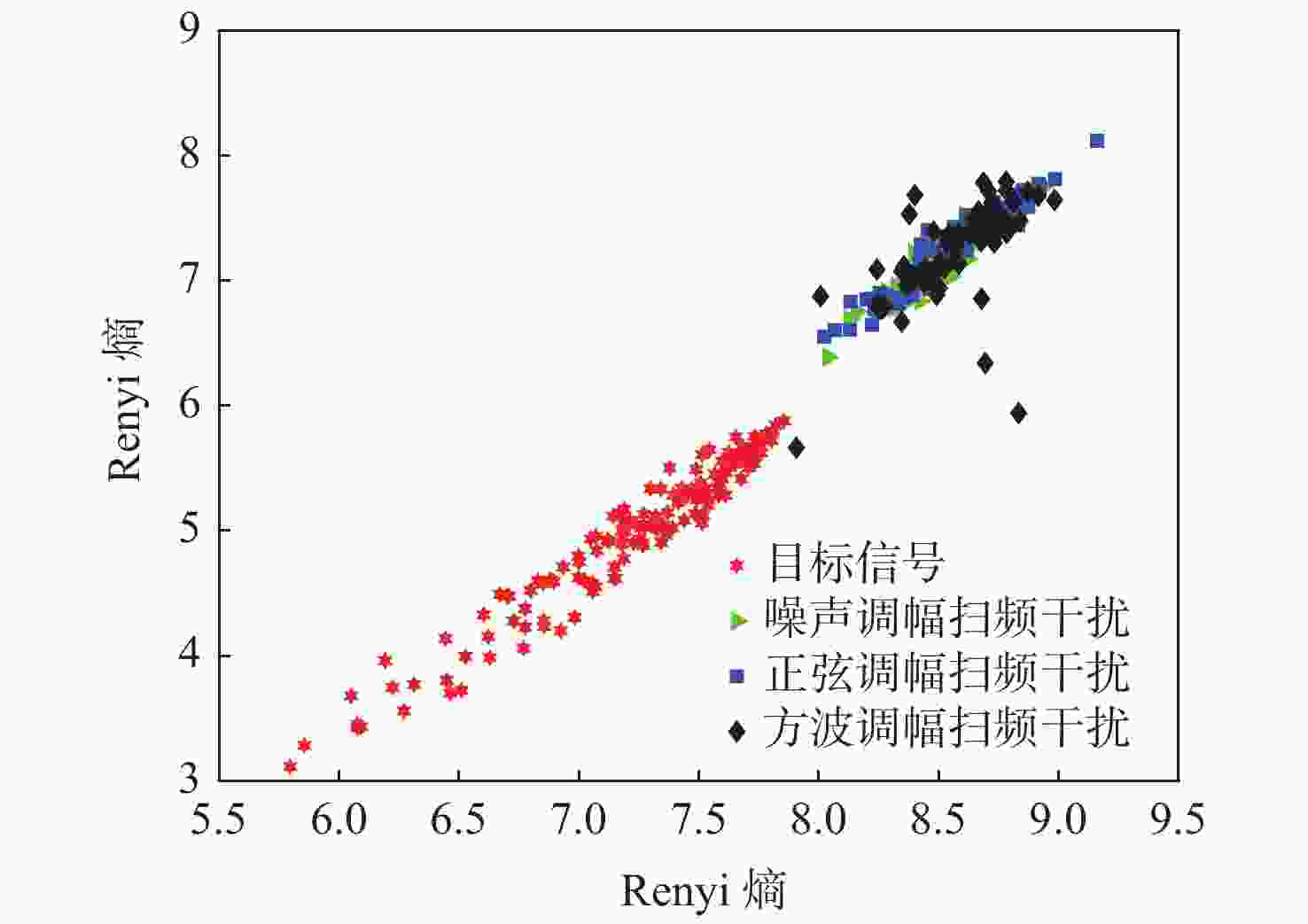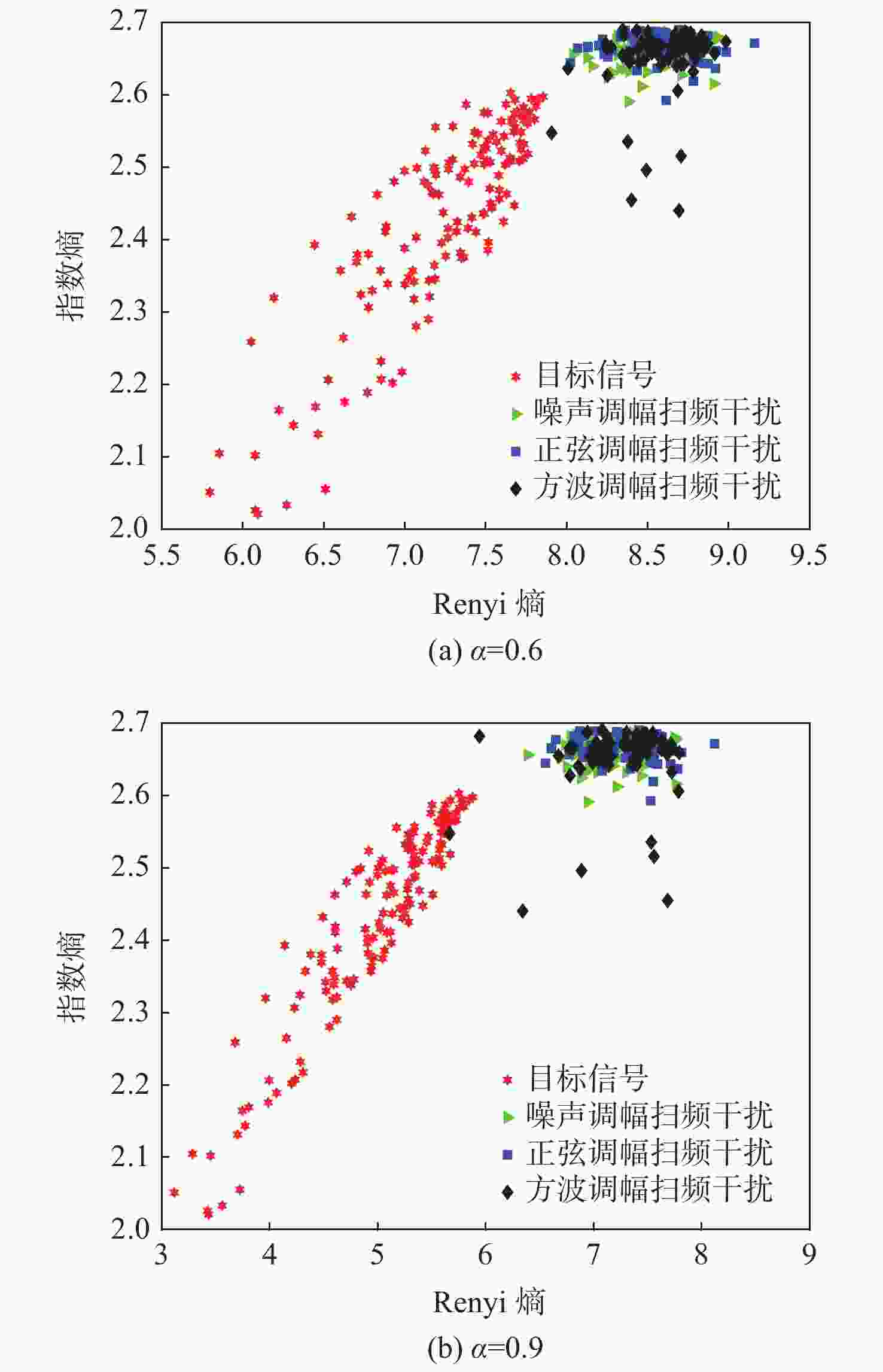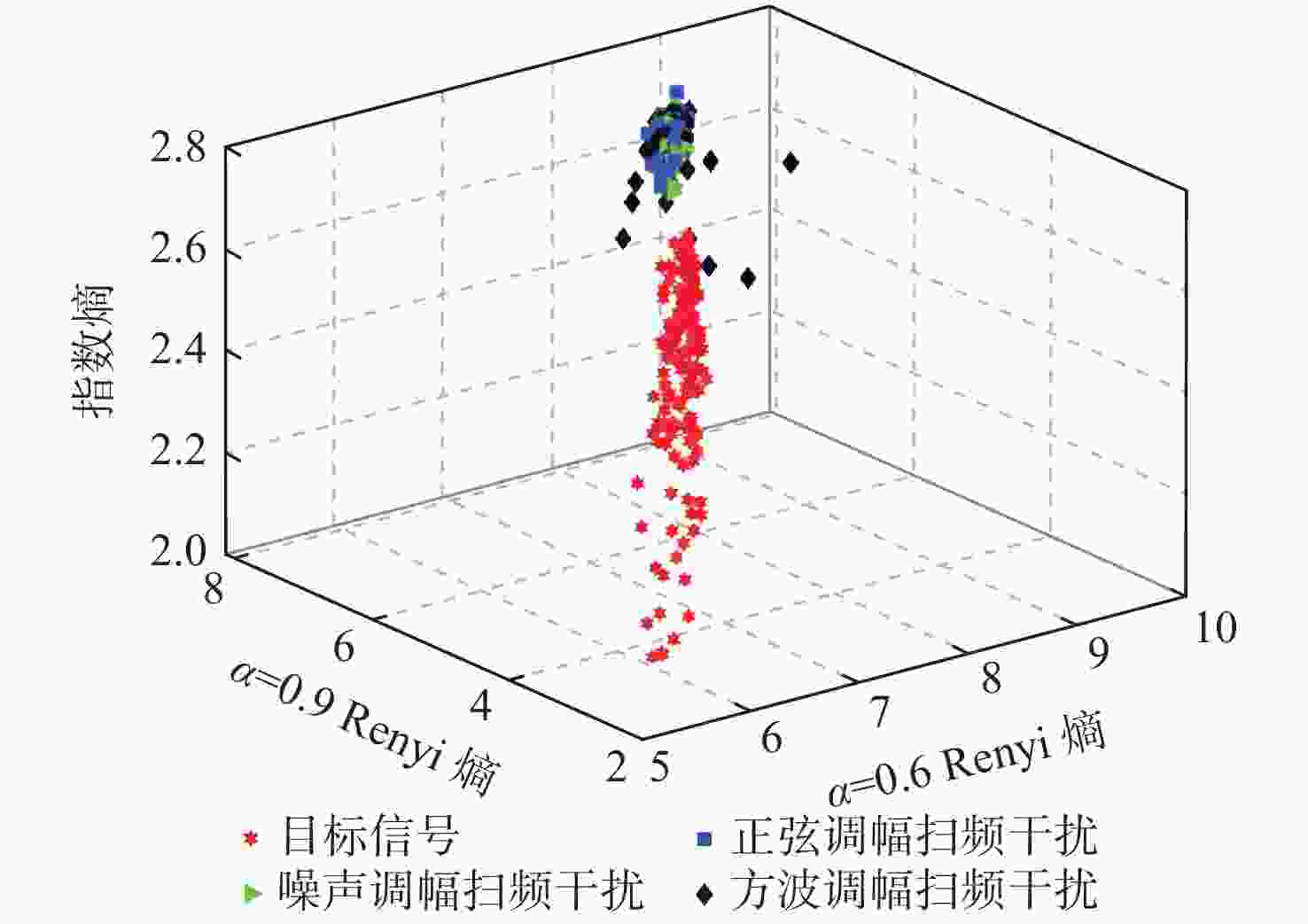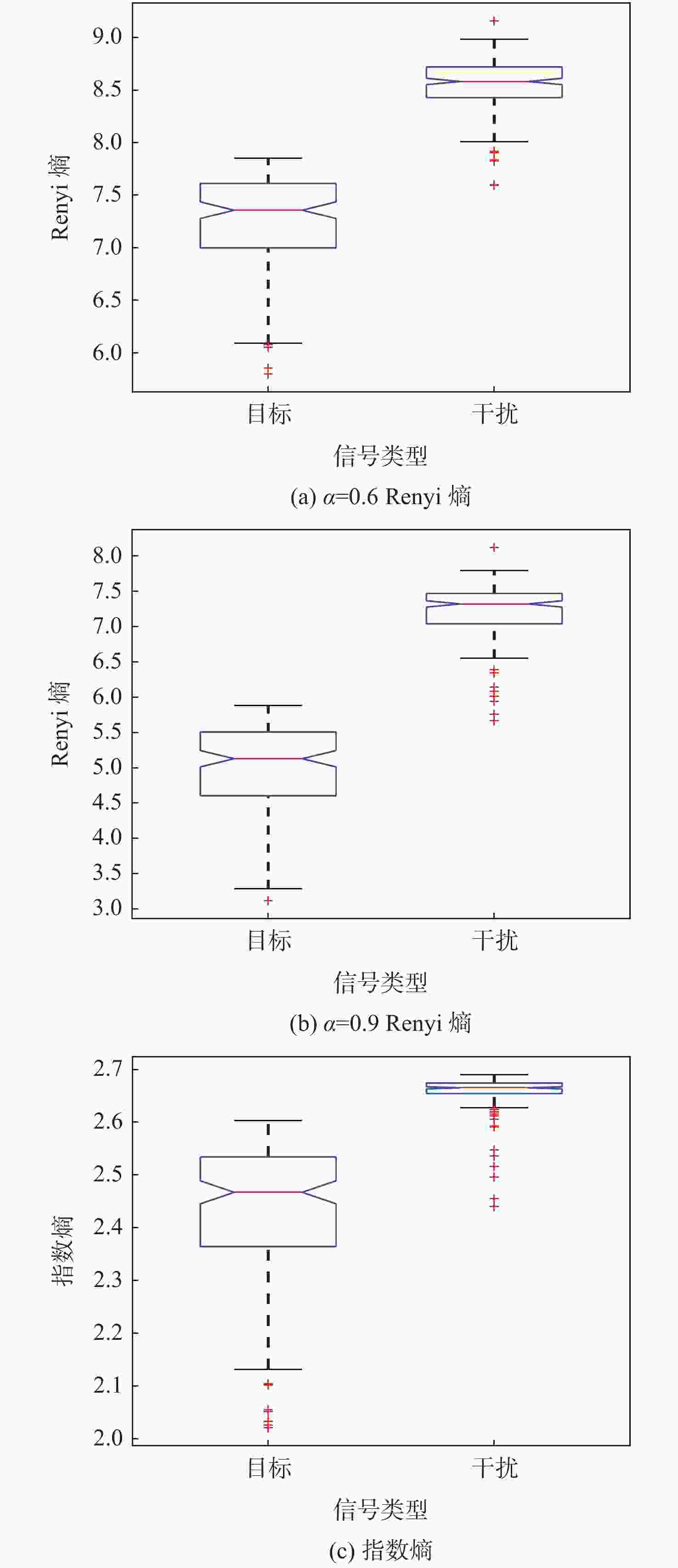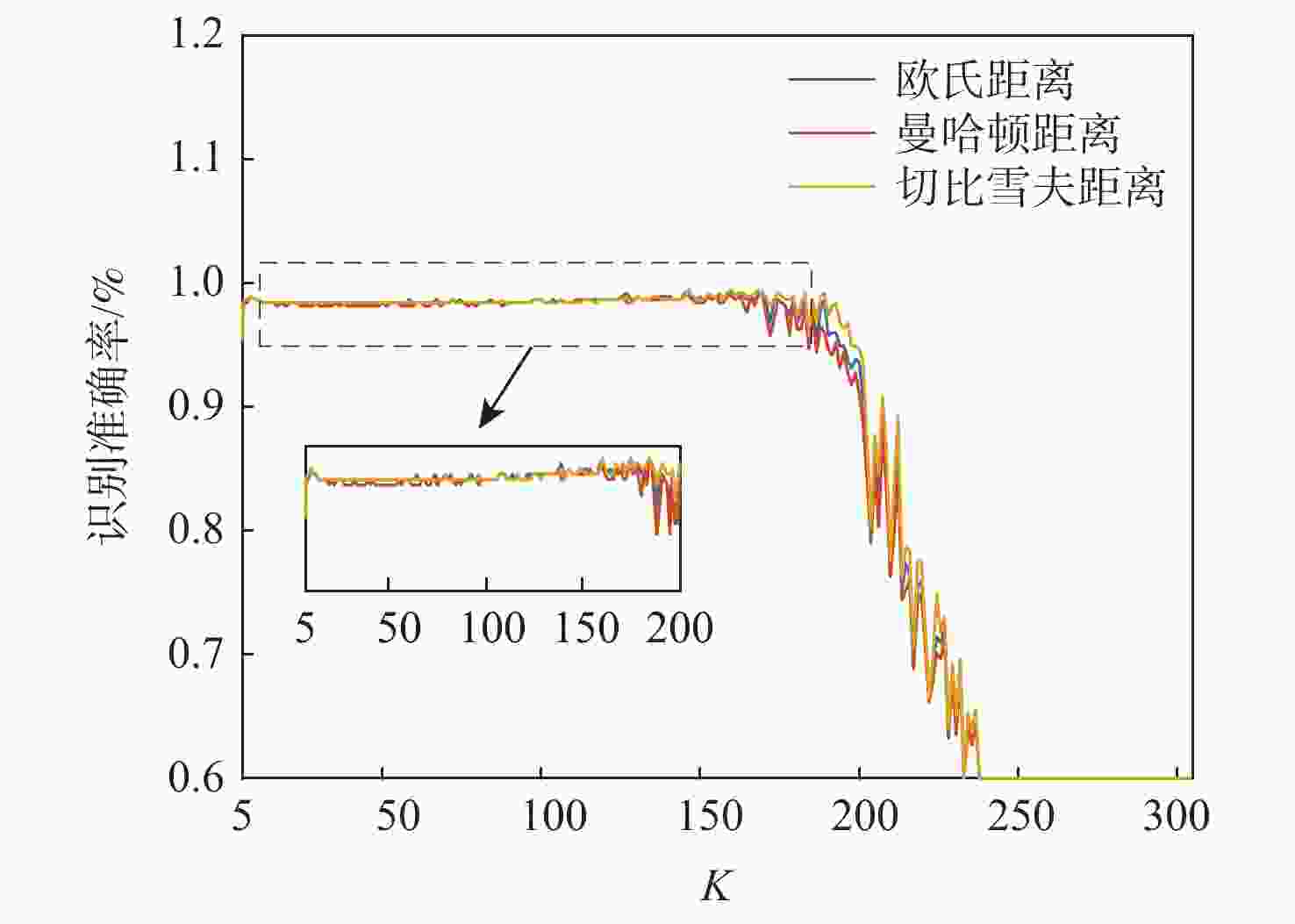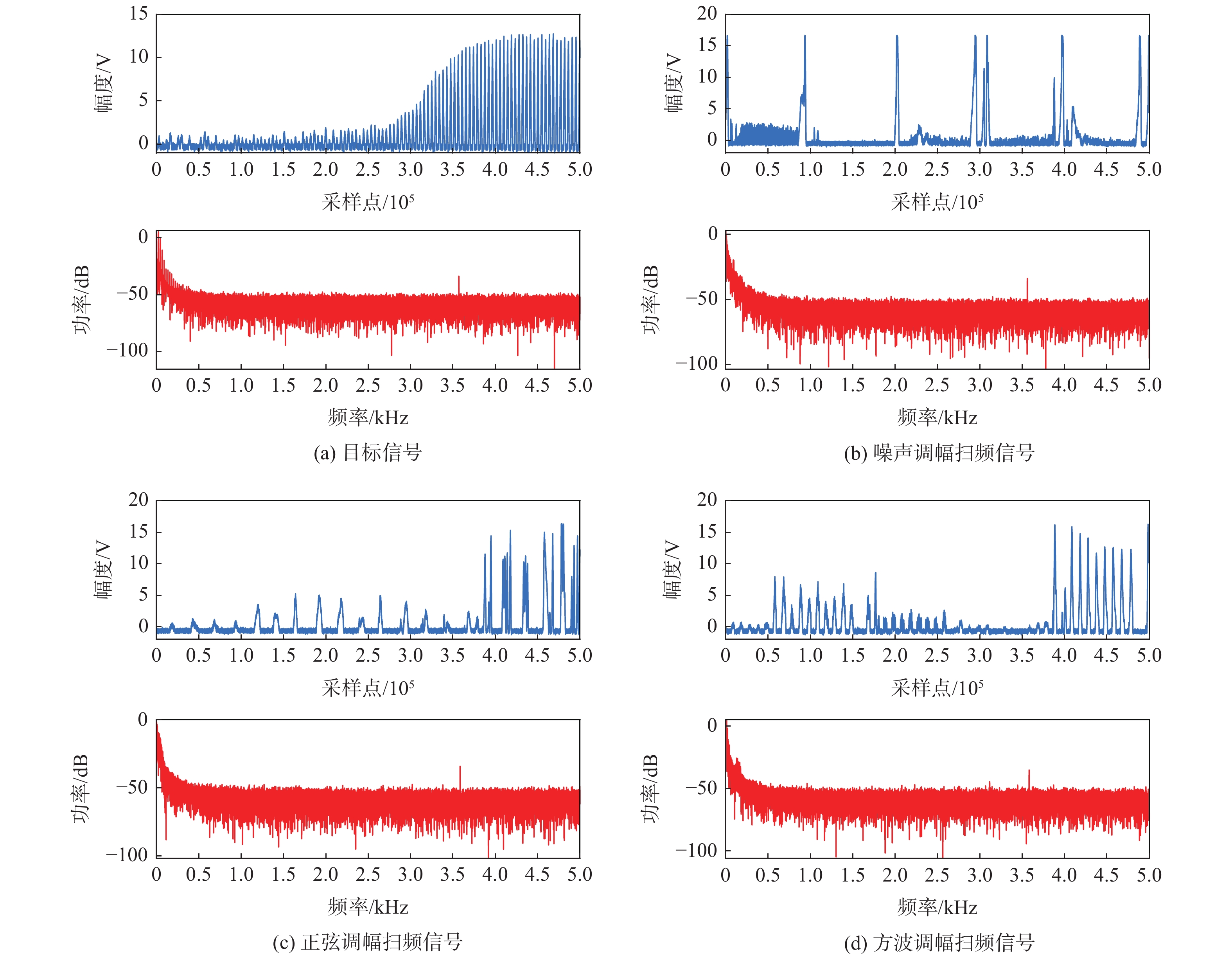Classification method of radio fuze target and interference signal based on power spectrum entropy
-
摘要:
无线电调频引信在战场环境容易受到干扰信号的干扰导致早炸,丧失打击能力。为提升无线电调频引信抗干扰能力,准确识别引信目标与干扰信号,提出一种基于功率谱熵特征的无线电调频引信目标与干扰信号分类识别方法。利用实测采集的无线电引信检波端输出信号,通过提取目标和干扰信号的功率谱指数熵和Renyi熵特征构成特征向量,作为K邻近(KNN)分类器的输入进行目标和干扰信号分类识别,并利用5-折交叉检验方法对其进行验证。结果表明:目标和干扰信号的功率指数熵和Renyi熵具有显著差异性,使用KNN分类器对其进行分类识别时,最高的识别准确率可达99.47%。
Abstract:Radio frequency modulation fuze is easy to be disturbed by jamming signals in a battlefield environment, which lead to explosion early and loss of attack ability. In a combat setting, jamming signals can easily disrupt radio frequency modulation fuses, resulting in an early explosion and a loss of assault capability. In order to identify target and jamming signals accurately, a classification method based on signal power spectrum entropy is proposed. Using the measured output signals of radio fuze, the power spectrum exponential entropy and Renyi entropy of the target and jamming signals are extracted to form feature vectors, which is used as the input of KNN classifier to classify target and jamming signals, and verified by 5-fold cross validation method. The target and jamming signals' power spectrum exponential entropy and Renyi entropy are extracted from the radio fuze's measured output signals to create feature vectors. These vectors are then fed into a K-nearest neighbor (KNN) classifier to classify the target and jamming signals, and their classification is confirmed through the use of the 5-fold cross validation method.The results show that there is a significant difference between the power spectrum exponential entropy and Renyi entropy of the target and jamming signals, and the highest classification accuracy reaches 99.47% when the KNN classifier is used to classify the target and jamming signals.
-
表 1 不同特征Wilcoxon秩和检验结果
Table 1. Different features Wilcoxon rank-sum test results
目标与干扰信号特征 p h 结果 $ \alpha = 0.6 $ Renyi熵特征 $ 6.079\;6 \times {10^{ - 60}} $ 1 差异极显著 $ \alpha = 0.9 $ Renyi熵特征 $ 2.153\;2 \times {10^{ - 60}} $ 1 差异极显著 指数熵特征 $ 4.553\;4 \times {10^{ - 58}} $ 1 差异极显著 表 2 不同K值和距离计算方式识别准确率
Table 2. Recognition accuracy of different K values and distance calculation methods
距离计算方式 K 最优识别准确率/% 欧氏距离 170 99.20 曼哈顿距离 170 99.20 切比雪夫距离 187 99.47 -
[1] 崔占忠, 宋世和, 徐立新. 近炸引信原理 [M]. 2版. 北京: 北京理工大学出版社, 2005.CUI Z Z, SONG S H, XU L X. Principle of proximity fuze [M]. 2nd ed. Beijing: Beijing Insititute of Technology Press, 2005(in Chinese). [2] 赵惠昌. 无线电引信设计原理与方法 [M]. 北京: 国防工业出版社, 2012: 42-97.ZHAO H C. Fundamentals and methodology of radio fuze [M]. Beijing: National Defense Industry Press, 2012: 42-97(in Chinese). [3] 代健, 晏祺, 闫晓鹏, 等. 基于模糊c-均值增量更新的脉冲多普勒引信干扰与目标信号识别[J]. 兵工学报, 2018, 39(9): 1711-1718.DAI J, YAN Q, YAN X P, et al. Recognition of jamming and target signal for pulse doppler fuze based on FCM algorithm with incremental update[J]. Acta Armamentarii, 2018, 39(9): 1711-1718(in Chinese). [4] 郝新红, 杜涵宇, 陈齐乐. 调频引信粗糙面目标与干扰信号识别[J]. 北京航空航天大学学报, 2019, 45(10): 1946-1955.HAO X H, DU H Y, CHEN Q L. Rough surface target and jamming signal recognition of FM fuze[J]. Journal of Beijing University of Aeronautics and Astronautics, 2019, 45(10): 1946-1955(in Chinese). [5] 黄莹, 郝新红, 孔志杰, 等. 基于熵特征的调频引信目标与干扰信号识别[J]. 兵工学报, 2017, 38(2): 254-260.HUANG Y, HAO X H, KONG Z J, et al. Recognition of target and jamming signal for FM fuze based on entropy features[J]. Acta Armamentarii, 2017, 38(2): 254-260(in Chinese). [6] 李立元, 栗苹, 李国林, 等. 基于双谱分析的高原灌木回波信号分类[J]. 北京航空航天大学学报, 2022, 48(10): 2070-2078.LI L Y, LI P, LI G L, et al. Classification of plateau shrub echo signal based on bispectrum analysis[J]. Journal of Beijing University of Aeronautics and Astronautics, 2022, 48(10): 2070-2078(in Chinese). [7] 单剑锋, 翟波. 基于小波变换的无线电引信目标识别研究[J]. 弹箭与制导学报, 2009, 29(6): 288-290.SHAN J F, ZHAI B. Wavelet based target detection for radio fuze signal[J]. Journal of Projectiles, Rockets, Missiles and Guidance, 2009, 29(6): 288-290(in Chinese). [8] LI Z Q, HAO X H, CHEN H L, et al. Target signal recognition for CW doppler proximity radio detector based on SVM [C]//Proceedings of the International Conference on Mechatronic Sciences, Electric Engineering and Computer (MEC). Piscataway: IEEE Press, 2014: 1160-1163. [9] SHANNON C E. A mathematical theory of communication[J]. Bell System Technical Journal, 1948, 27(3): 379-423. doi: 10.1002/j.1538-7305.1948.tb01338.x [10] LONG D, SINGH V P. An entropy-based multispectral image classification algorithm[J]. IEEE Transactions on Geoscience and Remote Sensing, 2013, 51(12): 5225-5238. doi: 10.1109/TGRS.2013.2272560 [11] BARANIUK R G, FLANDRIN P, JANSSEN A J E M, et al. Measuring time-frequency information content using the Renyi entropies[J]. IEEE Transactions on Information Theory, 2001, 47(4): 1391-1409. doi: 10.1109/18.923723 [12] 李一兵, 常国彬, 叶方. 基于指数熵的认知无线电频谱感知算法[J]. 吉林大学学报(工学版), 2014, 44(5): 1506-1511.LI Y B, CHANG G B, YE F. Exponential entropy-based spectrum sensing algorithm in cognitive radio[J]. Journal of Jilin University (Engineering and Technology Edition), 2014, 44(5): 1506-1511(in Chinese). [13] KONG Z J, LI P, YAN X P, et al. Anti-sweep jamming design and implementation using multi-channel harmonic timing sequence detection for short-range FMCW proximity sensors[J]. Sensors, 2017, 17(9): 2042. doi: 10.3390/s17092042 [14] 陈齐乐, 郝新红, 闫晓鹏, 等. 基于谐波系数幅值平均的复合调制引信抗扫频式干扰方法[J]. 北京航空航天大学学报, 2020, 46(7): 1317-1324.CHEN Q L, HAO X H, YAN X P, et al. Anti sweep jamming method of hybrid modulation fuze based on harmonic coefficient amplitude averaging[J]. Journal of Beijing University of Aeronautics and Astronautics, 2020, 46(7): 1317-1324(in Chinese). [15] PAN Z B, WANG Y K, PAN Y W. A new locally adaptive K-nearest neighbor algorithm based on discrimination class[J]. Knowledge-Based Systems, 2020, 204: 106185. doi: 10.1016/j.knosys.2020.106185 [16] 韩磊, 周帅. 基于FLAKNN的雷达一维距离像目标识别[J]. 北京理工大学学报, 2021, 41(6): 611-618.HAN L, ZHOU S. Radar range profile target recognition based on FLAKNN[J]. Transactions of Beijing Institute of Technology, 2021, 41(6): 611-618(in Chinese). [17] XING W C, BEI Y L. Medical health big data classification based on KNN classification algorithm[J]. IEEE Access, 2019, 8: 28808-28819. -







 下载:
下载:
